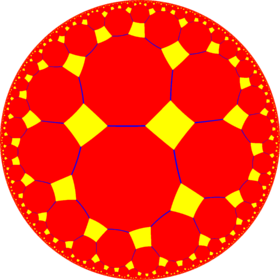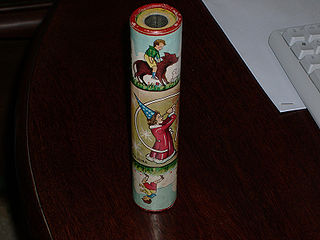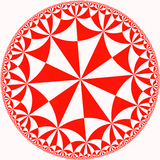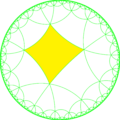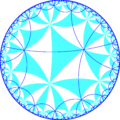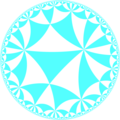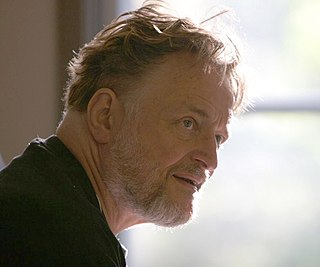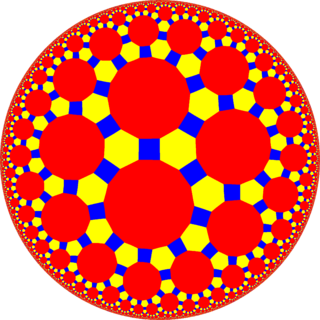
In geometry, the truncated trioctagonal tiling is a semiregular tiling of the hyperbolic plane. There are one square, one hexagon, and one hexadecagon (16-sides) on each vertex. It has Schläfli symbol of tr{8,3}.
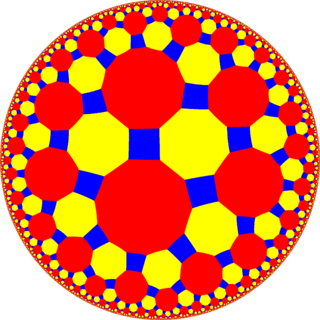
In geometry, the truncated tetrahexagonal tiling is a semiregular tiling of the hyperbolic plane. There are one square, one octagon, and one dodecagon on each vertex. It has Schläfli symbol of tr{6,4}.

In geometry, the truncated order-6 square tiling is a uniform tiling of the hyperbolic plane. It has Schläfli symbol of t{4,6}.
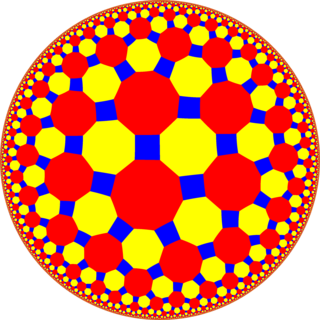
In geometry, the truncated tetrapentagonal tiling is a uniform tiling of the hyperbolic plane. It has Schläfli symbol of t0,1,2{4,5} or tr{4,5}.

In geometry, the order-8 triangular tiling is a regular tiling of the hyperbolic plane. It is represented by Schläfli symbol of {3,8}, having eight regular triangles around each vertex.

In geometry, the truncated order-8 triangular tiling is a semiregular tiling of the hyperbolic plane. There are two hexagons and one octagon on each vertex. It has Schläfli symbol of t{3,8}.

In geometry, the truncated order-6 hexagonal tiling is a uniform tiling of the hyperbolic plane. It has Schläfli symbol of t{6,6}. It can also be identically constructed as a cantic order-6 square tiling, h2{4,6}

In geometry, the truncated tetraheptagonal tiling is a uniform tiling of the hyperbolic plane. It has Schläfli symbol of tr{4,7}.

In geometry, the truncated order-4 octagonal tiling is a uniform tiling of the hyperbolic plane. It has Schläfli symbol of t0,1{8,4}. A secondary construction t0,1,2{8,8} is called a truncated octaoctagonal tiling with two colors of hexakaidecagons.

In geometry, the truncated tetraoctagonal tiling is a semiregular tiling of the hyperbolic plane. There are one square, one octagon, and one hexakaidecagon on each vertex. It has Schläfli symbol of tr{8,4}.

In geometry, the truncated order-8 octagonal tiling is a uniform tiling of the hyperbolic plane. It has Schläfli symbol of t0,1{8,8}.

In geometry, the order-3 apeirogonal tiling is a regular tiling of the hyperbolic plane. It is represented by the Schläfli symbol {∞,3}, having three regular apeirogons around each vertex. Each apeirogon is inscribed in a horocycle.

In geometry, the truncated triapeirogonal tiling is a uniform tiling of the hyperbolic plane with a Schläfli symbol of tr{∞,3}.

In geometry, the truncated order-4 apeirogonal tiling is a uniform tiling of the hyperbolic plane. It has Schläfli symbol of t{∞,4}.
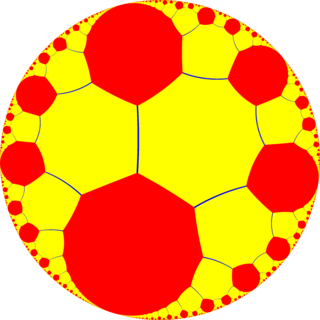
In geometry, the truncated infinite-order square tiling is a uniform tiling of the hyperbolic plane. It has Schläfli symbol of t{4,∞}.
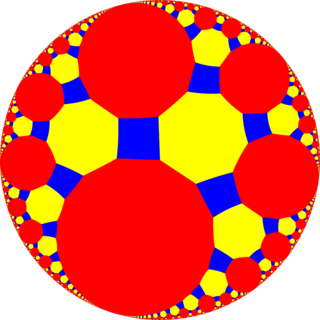
In geometry, the truncated tetraapeirogonal tiling is a semiregular tiling of the hyperbolic plane. There are one square, one octagon, and one apeirogon on each vertex. It has Schläfli symbol of tr{∞,4}.

In geometry, the truncated tetrahexagonal tiling is a semiregular tiling of the hyperbolic plane. There are one square, one decagon, and one dodecagon on each vertex. It has Schläfli symbol of t0,1,2{6,5}. Its name is somewhat misleading: literal geometric truncation of pentahexagonal tiling produces rectangles instead of squares.

In geometry, the truncated hexaoctagonal tiling is a semiregular tiling of the hyperbolic plane. There are one square, one dodecagon, and one hexakaidecagon on each vertex. It has Schläfli symbol of tr{8,6}.

In geometry, the truncated order-6 octagonal tiling is a uniform tiling of the hyperbolic plane. It has Schläfli symbol of t{8,6}.
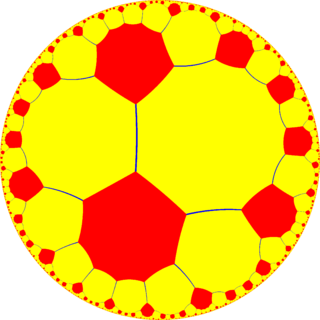
In geometry, the truncated order-8 hexagonal tiling is a semiregular tiling of the hyperbolic plane. It has Schläfli symbol of t{6,8}.
